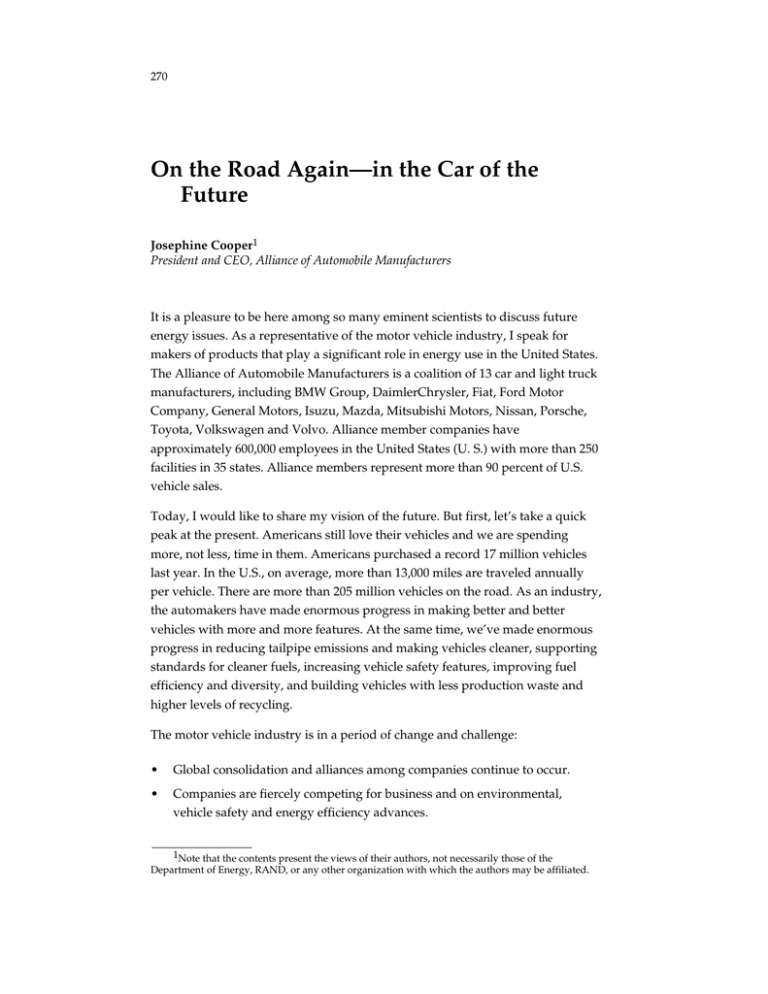On the Road Again—in the Car of the Future
advertisement

270 On the Road Again—in the Car of the Future Josephine Cooper1 President and CEO, Alliance of Automobile Manufacturers It is a pleasure to be here among so many eminent scientists to discuss future energy issues. As a representative of the motor vehicle industry, I speak for makers of products that play a significant role in energy use in the United States. The Alliance of Automobile Manufacturers is a coalition of 13 car and light truck manufacturers, including BMW Group, DaimlerChrysler, Fiat, Ford Motor Company, General Motors, Isuzu, Mazda, Mitsubishi Motors, Nissan, Porsche, Toyota, Volkswagen and Volvo. Alliance member companies have approximately 600,000 employees in the United States (U. S.) with more than 250 facilities in 35 states. Alliance members represent more than 90 percent of U.S. vehicle sales. Today, I would like to share my vision of the future. But first, let’s take a quick peak at the present. Americans still love their vehicles and we are spending more, not less, time in them. Americans purchased a record 17 million vehicles last year. In the U.S., on average, more than 13,000 miles are traveled annually per vehicle. There are more than 205 million vehicles on the road. As an industry, the automakers have made enormous progress in making better and better vehicles with more and more features. At the same time, we’ve made enormous progress in reducing tailpipe emissions and making vehicles cleaner, supporting standards for cleaner fuels, increasing vehicle safety features, improving fuel efficiency and diversity, and building vehicles with less production waste and higher levels of recycling. The motor vehicle industry is in a period of change and challenge: • Global consolidation and alliances among companies continue to occur. • Companies are fiercely competing for business and on environmental, vehicle safety and energy efficiency advances. ________________ 1Note that the contents present the views of their authors, not necessarily those of the Department of Energy, RAND, or any other organization with which the authors may be affiliated. 271 • Technological advances are occurring at a faster pace than ever before. • Regulatory hurdles are set higher and higher. • Partnerships with government and allies flourish. • Consumers are demanding new features and enhanced performance as they choose new vehicles. The industry is truly at a crossroads as we begin this new millennium. For the last century automakers have been perfecting the internal combustion engine with major advances in electronics, computers and advanced environmental technology. The fuel of choice has been gasoline. Why? Because it simply has provided the most “bang for the buck” in terms of providing performance for cars and light trucks. Moreover, it is widely available, inexpensive, relatively fuel efficient and it is a fuel that consumers have become comfortable with over all these years. And the gasoline burned in today’s cars and light trucks is quickly becoming much cleaner than even 10 years ago. The government regulators, both the California Air Resources Board (CARB) and the Environmental Protection Agency (EPA), have recognized that cars and fuels must be considered as a system, if we are to make our vehicles the cleanest in the world. We, and our partners in the oil industry, can be proud of what we have been able to achieve so far with today’s technology –96-99 percent control on smog-forming pollutants. Under the new Federal emission standards adopted for the 2004 model year, and with the continued help of the oil industry, the next generation of vehicles will reduce emissions by another 70 – 80 percent beyond today’s already low levels. To give you an example of how far we’ve come, a personal watercraft (e.g. Jet Ski) pollutes more in seven hours than driving a new car 100,000 miles (that’s over four times around the earth at the equator). Automakers also are working to dramatically improve fuel efficiency. Over the past 20 years, fuel efficiency in all cars has been improved by more than 100 percent. Today’s pickup, minivan and SUV get better mileage than a subcompact car from the 1970s. Advanced technologies offer the promise of even greater fuel efficiency gains. Worldwide, we are working for consistently clean vehicles and fuels. In the World-wide Fuel Charter, automakers around the world have agreed on fuel quality requirements for optimum emissions performance for a range of regulatory regimes. Over the long term, the automakers’ goal is to have globally harmonized standards for vehicles and their fuels that represent best practices globally. The fuel charter sets the stage for this to become reality. 272 What we’re here to discuss today at E-Vision 2000 is what will the future look like. The automakers’ vision for the future is premised on achieving technological breakthroughs for vehicles. These breakthroughs will embrace additional environmental improvements, enhanced fuel efficiency and vehicle safety. New technologies must be acceptable to the market in all areas, including price, utility, and performance. Clearly, there is a lot on our horizons. Let’s take a closer look. Lean-Burn Gasoline Engine One promising new technology is the lean-burn gasoline engine, with significant fuel economy advantages over ordinary gasoline engines. These engines need extremely clean gasoline, even cleaner than what was recently adopted by EPA, to allow the use of sophisticated control technology. Advanced Turbocharged Diesel Engines An even more promising option is the advanced turbocharged diesel engine for the light duty market. The challenge is to make light duty diesel vehicles as clean and as consumer-friendly as today’s gasoline vehicles. This will be a challenge technologically, and it will require much cleaner diesel fuel than in use today. But rising to these challenges will be worth it because diesel technology has the potential for improving fuel efficiency by 40% over today’s gasoline engines. In Europe today, clean diesels power more than 25% of the vehicle market. They are quiet, clean diesels (i.e., no black smoke), not the old diesel vehicles that were once sold here in the U.S. or like the “smoky” urban buses we still see in our cities. Alliance members and other international automakers are working individually and with governments in research and development of advanced technologies. Cooperative research programs between the U.S. industry and government, most notably the Partnership for a New Generation of Vehicles (PNGV), are underway with the goal of achieving technology breakthroughs that will then be integrated into new vehicle fleets. The initiative aims to develop fuel-efficient concept cars having a fuel economy of 80 miles per gallon by 2004 and is investigating fuel cell cars and lean-burn technologies as options with great potential for success. Hybrid Electric Vehicle Another emerging technology that is available on the market today is a hybridelectric vehicle, which combines an electric powertrain with either a gasoline or 273 diesel internal combustion engine. Electric motors produce a lot of torque -- and for those of you who don’t know -- it is torque that is important in quick acceleration, not horsepower. I know because I’m one of those people who like fast, good handling cars. By using the electric motors to provide quick acceleration, the companion gasoline or diesel engine can be made smaller, cleaner and more efficient. Because of this combination of powertrains, hybridelectric vehicles can provide good performance with excellent fuel economy in city driving, where most of us drive. Toyota introduced the Prius into U.S. markets this year, the first mass-produced hybrid electric vehicle, and other automakers are preparing to introduce more hybrids. Battery Electric Vehicles And I can’t leave the subject of technology development without mentioning battery-electric vehicles (BEVs). The California Air Resources Board adopted a rule in 1990 that requires automakers to build “zero-emission” vehicles (ZEVs). I won’t review the long history of this mandate and all that has transpired, but it is clear from our experience in California that BEVs at best will meet only a nichemarket need. While the Alliance member companies have built quiet, comfortable BEVs, in every other way like today’s best vehicles, the extremely expensive battery material – which drives the cost of these vehicles very high – and the limited driving range that is available because of the charge capacity of the battery pack, means that this is not a technology we can plan on for the long term. Alternative Fuel Vehicles Even with all of these advances, we recognize that society may desire other transportation options. That is why our members have developed alternativefueled vehicles. Energy sources for these vehicles include methanol, ethanol, compressed natural gas (CNG), liquid petroleum gas (LPG) and hydrogen. Such vehicles have not sold in large numbers – most of these fuels can’t compete on a cost and power-per-unit volume with gasoline. Moreover, some of the modifications to the vehicles needed to allow the use of these fuels make these vehicles more expensive. More than 25 variations of alternate fuel vehicles are currently available. Automakers have learned over the years that consumers like evolutionary change in their vehicles, not revolutionary changes in how things work. Some of the problems of advancing penetration of alternative-fueled vehicles are simply that the fueling infrastructure can be very different from the familiar “pull up to 274 the pump -- insert nozzle -- and fuel” regime that we are used to today. In addition, in most locations of the U.S., an alternative fuel infrastructure simply does not exist. This is a huge obstacle. Fuel Cell Vehicles Beyond these more familiar possibilities, our members also are working to develop vehicles powered by fuel cells. This technology is something the industry is very excited about. Fuel cells combine hydrogen with oxygen to produce electrical energy, offering the promise of zero emissions. The only by product is water vapor. Manufacturers are working hard to make the cost of fuel cell vehicles competitive with today’s cars. We aren’t there yet, but tremendous strides have taken place. Now you might remember that fuel cells were used in some of the earliest space flights and, of course, NASA supplied the space capsules with an adequate amount of hydrogen fuel for these devices. We all know that cost and the ability to mass-produce are not the same high priority with NASA as they are in the auto industry. Fuel cell technology can use any of several sources of hydrogen, including gasoline, methanol and hydrogen gas. The only constant requirement is that the fuel has to be ultra-clean because impurities will prevent the technology from operating. In fact, we may see fuel cells at residential locations for powering homes before we see them commercially for motor vehicles, because it is easier to package the equipment for stationary use and it doesn’t require the same sort of infrastructure that vehicles require. This development may hold clues, however, for how the fuel cell vehicle market and infrastructure ultimately develops. Again, as with alternative-fuel vehicles, the refueling infrastructure will be critically important in determining whether this vehicle technology fills a niche market or plays a more dominant role in the vehicle fleet. Even if gasoline becomes the fuel of choice, it will need to be super clean and may require a separate infrastructure if it is phased in instead of replacing the existing fuel. One place to watch these developments in vehicle technology and fuel infrastructure is the Fuel Cell Partnership in California. This group includes automakers, energy suppliers, and government agencies, both Federal and State. Their goal is to work on the commercialization of fuel cell vehicles and determine what fuel infrastructure is the most appropriate for these vehicles. 275 While internal combustion engines will be with us for a long time, we may finally start to see fuel cells replacing internal combustion engines in 10-15 years. As noted above, fuel cells may appear in homes before wide spread use in cars – if there is a reformer in the house to convert some other fuel to hydrogen, it may even be feasible to adapt that system so that the owner can fuel his or her car with hydrogen at home! Challenges to Advanced Technology Vehicles There are many “gee whiz” technologies emerging today, but we will not get anywhere without considering consumers. The key to development of advanced technology vehicles lies in overcoming not only the hurdles and obstacles to their commercialization, but also acceptance by consumers. Creating the necessary infrastructure to support advanced technology vehicles is another critical factor in bringing vehicles to market. We need to entice consumers to buy them in sufficient volumes to make them a sustainable part of the market. To do that we must respond to all these consumer priorities: affordability, transparency (and by that I mean that the consumer sees virtually no difference in how she operates and fuels the vehicle), and the same or higher degrees of safety, performance, convenience, environmental controls, utility and reliability. If successful in meeting emerging regulatory standards plus consumer requirements for price, utility and performance, all of these developments will help stretch our existing petroleum-based energy resources. Information Technology Information technology is playing an increasingly significant role in improving overall vehicle efficiency. Automakers are using computers to better manage the energy and environmental systems in their cars and light trucks. Vehicles today have more computer controls than the Apollo rocket that took men to the moon. One of the most exciting developments on the horizon is the Intelligent Vehicle System, which will feature technology that can help improve both passenger safety and traffic flow. Some of the “intelligent” system features include vision enhancement, lane change and merge assistance, driver electronics, driver monitoring, vehicle diagnostics and rear-end impact warning. There are also automatic cruise controls that respond to the speed of the vehicle in front of you, road departure signals, and intersection stabilizers. Technology enhancements will speed up traffic flow by helping drivers avoid obstacles and minimize driver and vehicle reaction time to road conditions and other vehicles. As traffic flow is 276 improved, vehicles can operate more efficiently, reducing congestion and pollution, as well as consuming less fuel. What a wealth of choices consumers now have. Meeting the Future Whatever happens in the future, it is clear that the auto industry will be a major player, both as producers of the vehicles that consume energy and as the ones who will find solutions to the energy problems in the future. The industry is making high quality, advanced technology cars today that are ultra-clean, and for their size much more fuel-efficient than cars of the past. This industry is committed to “pushing the envelope” of technology development likely surpassing all of the advances we have made in the past. Given the lead time needed to invent the car or truck or SUV of the future, the developments we see today can only provide clues to a future we really cannot fully comprehend today Who knows? Maybe someday, we will all dump excess garbage into our vehicle fuel tanks, retract the wheels and contact the nearest air traffic controller as in “Back to the Future.” Whatever happens, this industry will be at the forefront of its development. We know many eminent scientists and futurists like you will be part of our vision for the future and we look forward to sharing tomorrow’s advancements with you.





